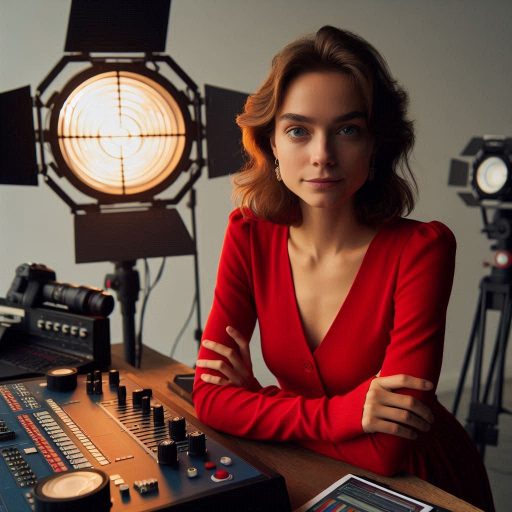Introduction
Lighting design projects play a vital role in shaping the aesthetics and functionality of spaces.
The right lighting can transform an ordinary environment into an extraordinary one.
It affects how people interact with their surroundings, making it an essential consideration in various projects.
Effective lighting enhances mood and atmosphere, influencing how individuals perceive and experience their environment.
In art galleries and museums, for instance, thoughtful lighting highlights the details of each piece, enhancing the viewer’s connection to the art.
In retail spaces, strategic lighting draws attention to products, encouraging sales and enhancing the shopping experience.
Similarly, in office environments, well-planned lighting can improve employee productivity and well-being.
Proper lighting creates an inviting atmosphere, promoting comfort for both employees and clients.
In residential projects, it fosters a cozy environment, making homes feel warm and welcoming for family and guests.
Despite its importance, lighting design projects often encounter common challenges that can hinder their success.
These challenges include managing energy efficiency, ensuring compliance with regulations, and coordinating with other design elements.
Additionally, designers must consider the unique requirements of each space and the expectations of their clients.
Understanding these challenges is crucial for designers aiming to create effective, sustainable, and beautiful lighting solutions.
Lack of communication
How Poor Communication Among Team Members
Effective communication is crucial in lighting design projects.
Poor communication among team members often leads to misunderstandings and mistakes.
These issues can arise at any stage of the design process, from concept development to execution.
When team members fail to share information, the project suffers.
Inadequate communication can result in misaligned expectations and misinterpretations of design intent.
One common scenario involves the lighting designer and architect.
If the lighting designer does not clearly understand the architectural vision, their lighting solutions may not integrate well with the overall design.
For instance, if the architect envisions a specific ambiance, but the lighting designer uses overly bright fixtures, the result can clash with the intended atmosphere.
This disconnect can lead to a space that feels uninviting or harsh.
Miscommunication can also occur between the designer and electrician.
If the lighting designer does not provide clear installation instructions, electricians may make assumptions.
For example, if a designer specifies recessed lighting without indicating the exact placement, electricians might install fixtures incorrectly.
This can lead to uneven lighting, with some areas over-illuminated and others left too dim.
The final outcome may not meet the original design intent.
Examples of How Miscommunication Can Impact the Final Outcome of a Project
Budgetary misunderstandings are another common pitfall in lighting design projects.
If the project manager fails to communicate budget constraints effectively, designers may specify fixtures beyond the budget.
This oversight can lead to delays and frustrations when team members realize the proposed solutions are not feasible.
The team must revisit the design, often resulting in rushed decisions that compromise quality.
Timelines can also suffer due to poor communication.
If deadlines are not clearly defined, team members may have differing expectations regarding project completion.
A lack of synchronized timelines can lead to delays in fixture selection or installation.
For example, if the electrician is not aware of the schedule, they might not be ready when it is time to install the lighting.
This misalignment can push back project completion and lead to cost overruns.
Another example of miscommunication involves the feedback process.
If team members do not share critiques or suggestions openly, issues may go unaddressed.
For instance, if a designer implements a lighting scheme without gathering feedback from the client, the final result may not align with the client’s vision.
This can lead to dissatisfaction and require costly revisions.
Read: Visual Merchandiser: Job Market and Opportunities
Budget constraints
Limited Budget as a Challenge
A limited budget can restrict your choices in lighting fixtures.
High-quality fixtures often come at a premium price.
When budgets are tight, designers may feel pressured to opt for cheaper options.
Unfortunately, lower-cost fixtures can compromise the overall effectiveness of the design.
They may lack the necessary features or durability, resulting in higher long-term costs.
Additionally, budget constraints can limit access to advanced lighting technologies.
Innovative solutions, such as smart lighting systems, may be out of reach.
These systems can enhance efficiency and flexibility in design but often come with higher upfront costs.
Consequently, working within a budget can lead to missed opportunities for improved functionality and aesthetics.
Designers must navigate these challenges to deliver effective lighting solutions.
Fortunately, there are strategies to maximize value while adhering to budget limitations.
Tips for Working Within Budget Constraints
First, prioritize your lighting needs based on the project‘s goals.
Identify essential areas that require quality lighting and allocate funds accordingly.
Focus on key spaces like reception areas or display zones.
These areas often benefit most from high-quality lighting and create lasting impressions.
Second, consider using a mix of fixture types.
For instance, combine decorative fixtures with energy-efficient LEDs.
This approach allows you to achieve a stylish look without sacrificing functionality.
Balance aesthetic appeal with cost-effectiveness by choosing fixtures that meet both criteria.
Third, explore options for wholesale or bulk purchasing.
Many suppliers offer discounts for bulk orders, which can reduce overall costs.
Research multiple vendors to find the best deals on high-quality fixtures.
Compare prices and specifications to ensure you get the best value.
Fourth, focus on energy-efficient technologies.
While initial costs may be higher, energy-efficient fixtures reduce long-term operating costs.
LEDs, for example, consume less energy and have longer lifespans than traditional bulbs.
Investing in energy-efficient technologies can lead to significant savings over time.
Finally, remain flexible and open to alternative solutions.
Sometimes, innovative designs can achieve similar effects without the cost.
Consider using indirect lighting or creative layering techniques.
These methods can enhance ambiance while minimizing the need for expensive fixtures.
Read: Top Skills Needed for Art Educators and Instructors
Technical issues
Common Technical Challenges Faced in Lighting Design Projects
One major challenge in lighting design is compatibility issues.
Designers often face difficulties when integrating different lighting technologies.
For example, mixing LED fixtures with traditional incandescent or fluorescent lights can cause dimming and performance problems.
If fixtures are incompatible, they may not work harmoniously, affecting the overall design.
Power supply problems also frequently arise in lighting design projects.
Insufficient power supply can lead to flickering lights or complete outages.
This challenge is especially common in older buildings, where the existing electrical systems may not support new lighting technologies.
Maintenance difficulties can pose another significant issue.
Some lighting systems require specialized knowledge for installation and upkeep.
For instance, complex automated lighting controls may be challenging to manage without proper training.
Additionally, inaccessible fixtures can make routine maintenance cumbersome.
If maintenance is neglected, it can lead to compromised performance and increased costs over time.
Solutions to Overcome Technical Obstacles and Ensure Successful Project Completion
To address compatibility issues, designers should conduct thorough research before selecting lighting fixtures.
They must ensure that all components are compatible and meet project requirements.
Collaborating with manufacturers can provide insights into which products work best together.
Conducting pre-installation tests can also identify potential compatibility issues early in the process.
Regarding power supply problems, a detailed electrical assessment is essential.
Designers should evaluate the existing power infrastructure and calculate the total load requirements for the project.
Upgrading the electrical system may be necessary to support new fixtures and technologies.
Engaging a qualified electrician to perform these assessments will help ensure safety and compliance with regulations.
For maintenance difficulties, designers should consider accessibility during the planning phase.
Choosing fixtures that are easy to replace or service will save time and effort in the long run.
Implementing smart lighting systems can simplify maintenance by providing real-time data on fixture performance.
These systems can alert users to potential issues before they become major problems.
Training staff on the operation and maintenance of lighting systems is also vital.
Providing comprehensive training can empower team members to manage the systems effectively.
Creating detailed maintenance schedules can help ensure that all lighting fixtures remain in optimal condition.
Read: Breaking Down Iconic Movie Costumes
Changing requirements
Challenges of Dealing with Evolving Project Requirements and Client Demands Throughout the Design Process
Lighting design projects often face common challenges, especially regarding evolving project requirements and client demands.
As projects progress, clients may change their visions, budgets, or timelines.
These shifts can create uncertainty and stress for designers, impacting the overall project outcome.
One major challenge involves maintaining clear communication with clients.
Clients may not fully understand the implications of their requests.
This misunderstanding can lead to misaligned expectations and dissatisfaction with the final design.
To address this issue, designers must establish open lines of communication from the outset.
Regular check-ins and updates help ensure everyone remains on the same page.
Another significant challenge occurs when designers must adjust to unexpected changes in project scope.
Sometimes, clients realize they need additional features or adjustments mid-project.
These last-minute requests can disrupt the workflow and strain resources.
Designers should anticipate potential changes by incorporating flexibility into their plans.
Developing modular designs allows for easier modifications without compromising the overall vision.
Budget constraints also frequently impact lighting design projects.
Clients may need to alter their budgets due to financial considerations.
When this happens, designers must find ways to adapt while maintaining quality and aesthetics.
One effective strategy is to prioritize essential elements of the design.
By focusing on key features, designers can make necessary adjustments without sacrificing the overall impact.
Strategies for Adapting to Changes and Effectively Managing Shifting Project Goals
Time constraints present another challenge in managing shifting project goals.
Tight schedules can pressure designers to deliver results quickly.
This urgency can lead to mistakes or oversights, affecting the project‘s quality.
To mitigate this risk, designers should implement efficient project management techniques.
Utilizing project management software can streamline tasks and improve collaboration among team members.
When faced with evolving client demands, designers must remain adaptable.
Embracing change as a natural part of the design process can foster a positive mindset.
Designers should approach each challenge as an opportunity for creativity and innovation.
This perspective can lead to unique solutions that exceed client expectations.
Documentation plays a crucial role in managing project changes effectively.
Keeping detailed records of design discussions, decisions, and changes helps maintain clarity.
This documentation can serve as a reference point for both designers and clients.
It also provides a way to track progress and ensure accountability throughout the project.
In general, lighting design projects often encounter challenges related to evolving requirements and client demands.
Designers must develop strategies to adapt to these changes while managing shifting project goals.
By maintaining clear communication, incorporating flexibility, prioritizing essential elements, and utilizing efficient project management techniques, designers can navigate these challenges successfully.
Ultimately, embracing change can lead to innovative designs that delight clients and enhance the overall project outcome.
Read: Visual Merchandiser: Job Market and Opportunities

Energy efficiency concerns
One of the common challenges in lighting design projects is the growing emphasis on energy efficiency concerns.
As sustainability becomes a top priority in design projects, incorporating energy-efficient lighting solutions is crucial.
Challenges of Meeting Sustainability Requirements
Meeting sustainability requirements in lighting design projects can be challenging due to various factors
- Limited options: Energy-efficient lighting options may be limited, making it difficult to find the right solution for the project.
- Cost implications: Energy-efficient lighting fixtures and systems can be more costly upfront, affecting the project budget.
- Performance concerns: Some energy-efficient lighting solutions may not provide the desired level of lighting quality or consistency.
- Regulatory compliance: Meeting energy efficiency standards and regulations adds an additional layer of complexity to the design process.
Incorporating Eco-Friendly Lighting Designs
Despite these challenges, it is possible to incorporate eco-friendly lighting designs while maintaining project goals and client satisfaction.
Here are some insights on how to achieve this:
- Conduct a thorough assessment: Start by assessing the project requirements and goals to determine the most suitable energy-efficient lighting solutions.
- Collaborate with suppliers: Work closely with lighting manufacturers and suppliers to explore eco-friendly options that meet performance requirements.
- Consider lifecycle costs: While energy-efficient lighting may have higher upfront costs, consider the long-term savings in energy consumption and maintenance.
- Opt for smart lighting controls: Incorporate smart lighting controls to optimize energy usage and improve overall efficiency in the design.
- Educate clients: Educate clients about the benefits of energy-efficient lighting and involve them in the decision-making process to ensure their satisfaction.
By addressing energy efficiency concerns and incorporating eco-friendly lighting designs, designers can create sustainable and environmentally responsible lighting solutions that meet the needs of modern design projects.
You Might Also Like: Best Online Courses for Furniture Design
Regulatory compliance
When it comes to lighting design projects, one of the common challenges that designers face is regulatory compliance.
Ensuring that your project meets building codes, safety regulations, and industry standards is crucial for the success of the project.
Importance of Regulatory Compliance
Complying with regulatory requirements is essential to guarantee the safety and well-being of the occupants of the building.
Building codes are put in place to ensure that structures are safe, energy-efficient, and accessible to all individuals.
Transform Your Career Today
Unlock a personalized career strategy that drives real results. Get tailored advice and a roadmap designed just for you.
Start NowBy adhering to safety regulations, you can prevent accidents and injuries that may result from inadequate lighting design.
Following industry standards also helps in achieving optimal performance and quality in your lighting project.
Navigating Regulatory Requirements
Understanding and navigating regulatory requirements can be a daunting task, but it is necessary to ensure project compliance from start to finish.
Here are some guidance to help you navigate through regulatory challenges
- Stay Informed: Keep yourself updated with the latest building codes, safety regulations, and industry standards relevant to your lighting design project.
- Consult Experts: Seek guidance from professionals who are well-versed in regulatory requirements to ensure that your project meets all necessary standards.
- Plan Early: Consider regulatory compliance from the early stages of your project to avoid costly and time-consuming modifications later on.
- Document Everything: Keep detailed records of your compliance efforts, including design decisions, approvals, and inspections, to demonstrate compliance with regulations.
By following these guidelines and staying proactive in addressing regulatory challenges, you can effectively navigate through regulatory requirements and ensure that your lighting design project complies with all necessary standards.
Aesthetics vs. functionality
Balancing Aesthetic Design Preferences with Functional Lighting Requirements
Aesthetic design preferences often prioritize style over functionality.
Clients may desire visually stunning fixtures or dramatic effects that enhance the space.
However, these choices can sometimes compromise the practical aspects of lighting.
For example, a beautiful pendant light might not provide sufficient illumination for a workspace.
Conversely, functional lighting often lacks visual appeal.
Bright, utilitarian fixtures might illuminate a space effectively but fail to enhance its aesthetic.
This disconnect can lead to dissatisfaction among clients who want both style and performance.
Designers must address these competing interests to create successful lighting solutions.
Designers can use various strategies to navigate this dilemma.
Start by understanding the specific needs and goals of the project.
Conduct thorough consultations with clients to grasp their aesthetic preferences and functional requirements.
Ask targeted questions to identify essential lighting tasks within the space.
Tips for Achieving a Harmonious Blend of Style and Functionality
Incorporate Layered Lighting
Use a combination of ambient, task, and accent lighting to achieve a balanced effect.
Ambient lighting provides overall illumination, while task lighting focuses on specific areas.
Accent lighting highlights artwork or architectural features.
This layering creates a visually appealing environment that meets various functional needs.
Select Versatile Fixtures
Choose fixtures that offer both aesthetic appeal and practical functionality.
Look for designs that complement the overall style while providing adequate light.
Consider options like dimmable LED fixtures, which can adjust to different moods and tasks.
Utilize Color Temperature
Select the right color temperature to enhance the aesthetic of the space.
Warmer tones create a cozy atmosphere, while cooler tones promote alertness.
Adjusting the color temperature can influence the overall feel of the design, ensuring it aligns with client preferences.
Consult Design Trends
Stay informed about current design trends that blend style with functionality.
Use popular styles as inspiration while maintaining the project‘s unique identity.
Integrating contemporary trends can attract clients while ensuring practical solutions.
Test the Lighting
Before finalizing your design, conduct mock-ups to test the lighting effects.
Observe how different fixtures interact with the space.
Adjust placement and brightness levels to achieve the desired balance between aesthetics and functionality.
In essence, the challenge of balancing aesthetic design preferences with functional lighting requirements is common in lighting design projects.
By employing strategies that prioritize both style and functionality, designers can meet client expectations and project objectives.
Thoughtful planning, effective communication, and creative solutions lead to harmonious lighting designs that enhance any space.
With careful consideration, designers can transform their visions into beautiful, functional realities.
Conclusion
In the realm of lighting design projects, there are several common challenges that designers often face.
One major obstacle is achieving the right balance between functionality and aesthetics.
Another challenge is staying within budget constraints while still meeting the client’s expectations for quality and design.
This requires careful planning and resource management.
Additionally, coordinating with multiple stakeholders, such as architects, engineers, and contractors, can be a challenge.
Effective communication is vital to ensure that everyone is on the same page.
Furthermore, integrating new technologies and sustainable practices into lighting design projects can present challenges.
Designers must stay current with the latest advancements in order to create innovative and eco-friendly solutions.
Lastly, meeting deadlines and managing project timelines can also be challenging.
Designers must prioritize tasks, allocate resources efficiently, and adapt to any unforeseen obstacles that may arise.
In closing, the key challenges in lighting design projects include balancing functionality and aesthetics, staying within budget, coordinating with stakeholders, integrating new technologies, and managing project timelines.
Proactive problem-solving, effective communication, and collaboration are essential to overcoming these challenges and achieving successful project outcomes.




